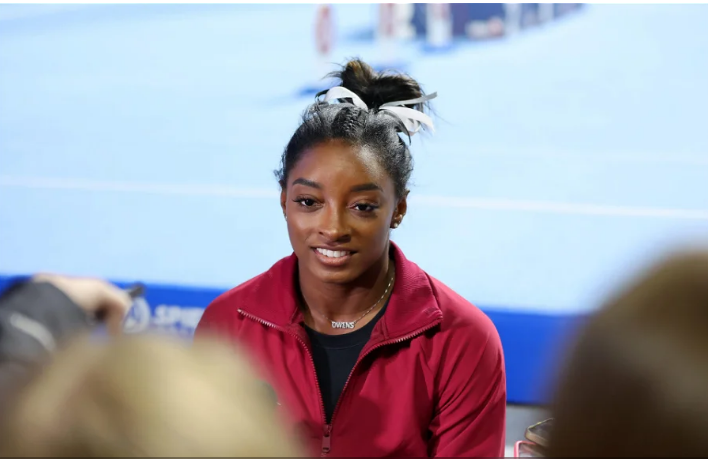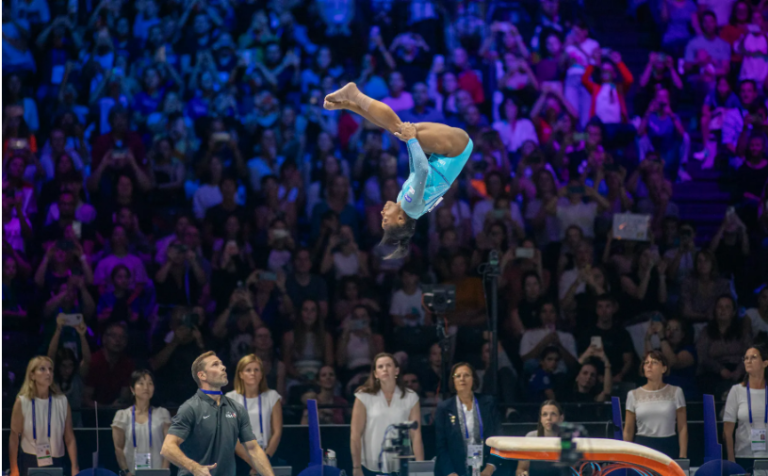The naming of a new skill in gymnastics doesn’t usually generate much fanfare. It’s mostly procedural. A gymnast’s federation submits the element at the start of an international event, such as the world championships or the Olympics, and if the athlete pulls it off, the element is named after them in the Code of Points. That’s about all there is to it.
But when it comes to Simone Biles, the most decorated gymnast in the history of the sport, everything is bigger, including the adulation the Houston-area native receives when a skill is named for her. When Biles stood at the end of the runway, ready to salute the judges before her first vault in the final rotation for the U.S. women’s qualification run at the 2023 Artistic Gymnastics World Championships in Antwerp, Belgium, everyone in the arena watched expectantly. She was finally going to get the Yurchenko double pike named for her. (“Yurchenko” refers to the method a gymnast uses to launch onto the vault table and is named after Natalia Vladimirovna Yurchenko, who introduced it in 1982.) It had taken more than two years to get to this point.

The anticipation for the Biles II—she already had a vault named for her back in 2018—started with a February 2021 interview on 60 Minutes during which the skill in training was showcased. Then she discussed the possibility of doing it in an interview with Texas Monthly that March. And then, a couple of months later, she finally did it in competition at the U.S. Classic. The skill went on the shelf for the subsequent Olympic trials, where she used her tried-and-true vaults, but all signs pointed toward her doing it at the Tokyo Olympics, where she landed it in a podium training session. Perhaps Biles was saving the double pike for the all-around final, where there was a one-touch warm-up, as she indicated in her TM interview.
But, as we all know, her day in the all-around finals never came, because during the team competition, Biles made the difficult decision to withdraw after getting dangerously lost in the air. That led her to withdraw from the all-around final and every apparatus final besides balance beam. After Tokyo, it was uncertain if we’d ever see the Yurchenko double pike in competition again, and if it would ever bear the Biles name.
But unlike other gymnasts who might be training to become the first to do a certain skill in international competition, Biles, at least, didn’t have to worry about another female athlete grabbing the naming rights. The Yurchenko double pike is considered all but unreplicable by anyone else. So far, the only Biles-named skill that another gymnast has managed to pull off in international competition is the very first element she ever had named for her, during her first world title run in 2013—a double layout with a half twist on floor exercise. And that happened just yesterday in Antwerp, when Panamanian gymnast Hillary Heron did it. (Biles was not actually the first gymnast to compete this element; it had been done in 2005 by U.S. gymnast London Phillips at a domestic competition, but a skill can only be named after a gymnast who performs it at a world-level event.)
The other skills that bear Biles’s name are so outrageously difficult—the double-double off beam, the triple-double on floor exercise—that it’s hard to envision anyone else doing them in competition. (Her first eponymous vault, a half on to a double twist, is probably possible for another gymnast—it’s a linear, not exponential, jump in difficulty from the more common 1.5-twister, but it’s tricky, and even Biles stopped doing it after just a couple of competitions.) The fact that her signature elements are out of reach to her peers is a testament to her once-in-ten-generations talent.
So even though she was unable to complete the skill in Tokyo, the Yurchenko double pike was waiting for Biles to claim upon her return to competitive gymnastics.
Unlike in 2021, when Biles did the vault at one meet and not at subsequent ones, this year the skill has become a mainstay of her repertoire. She did it at her comeback performance at the U.S. Classic this summer. She did it again at nationals. She did it at national team training camps. She did it at podium training for this week’s world championships. There was never any doubt, as there was in 2021, that we’d see this vault in international competition. Biles was clearly on a mission to put this element in the books.
When she stood at the end of the runway, the final gymnast up for Team USA in its final rotation, the entire crowd knew what they were about to see. In fact, they had just seen it not fifteen minutes earlier, when Biles did it in the warm-up. The crowd had gasped and then cheered as she launched upwards of eight feet into the air, rotated two and a half times, and then landed on the blue mats.
But even though the audience had already seen the vault in warm-ups, its desire to see it again hadn’t diminished at all. You have to try really hard to become jaded over a skill like this. I’ve now seen it in person a handful of times, and the thrill hasn’t worn off.
Besides, this competitive vault was the one that counted—for the team score, for the all-around and vault finals qualifications, and for the name. So Biles sprinted toward the vault one more time, hurdled into her roundoff, flipped backward onto the table, and propelled up and off into her flips. Her coach, Laurent Landi, was standing on the mat, tracking her as she reached her peak height and then stepping away as she rotated downward. In typical Biles fashion, she overpowered a vault that requires more power than any other female gymnast can hope to muster. Landi’s presence on the podium incurred a 0.5 neutral deduction—you’re only allowed a spotter on the uneven bars—but even after losing half a point, Biles earned a 15.266, the highest vault score of the women’s competition thus far. It’s unlikely that anyone will top it in subsequent rounds of qualification.
